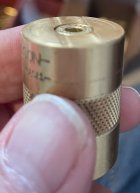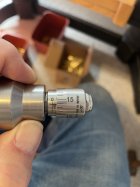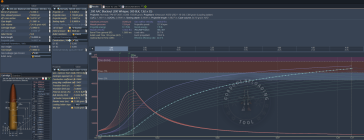Yes, I noted that. You had only .1 grain difference.
This is an interesting point. I haven't had enough time to get back to the range and gather data. As I have mentioned, I believe that everyone needs to test velocity for themsleves on their own firearms, even though the data is most likely reliable. I loaded up with data per the Hornady phone app for 300 AAC blackout. They had data to seat 2.210, but I was having a hard time seating to 2.235 as it was so compressed.
That is the one factor that could make a huge difference.
So, are you saying that by relaxing the load and moving the bullet out farther is what helped get those groups? I have rarely found my best groups at max load, so I tend to air for 0.5gr-1.0gr less.
I can't run a suppressor, yet. Lots of regulation is under scrutiny. That's mainly why I haven't been interested in subsonic very much. I wish I could. However, it still doesn't discount 300bo or 8.6bo with supersonic.
In general I want a small light rifle to use for hunting. My 300bo is the smallest of all of them. It is also the least deadly. Oh, I do have a bunch of subsonics I will use for home defense which have 210 gr SMKs, but I can't hunt with those in California as they are lead. The next lightest is a 12" 6.5 Grendel. And finally the heaviest is my 8.6 blackouts.
There is a lot there to sort out. Probably best is to link to where I tested the powder, and some others experiences with the same, more than 6 years ago. That way I’m not taxing my memory.
With CFE BLK a more dense load seems to lead to tighter groups and lower ES/SD numbers. Moving the bullet out creates the opposite. Less density, higher numbers. You’ll see that in my targets.
I use a drop tube for all my loading and a slow pour. This maximizes case capacity. In a small case like 300 Blackout, you can pick up more than a grain, or close to 5% more powder.
Suppressed ARs do not have to be dirty, or loud or Smokey. It takes careful load work up, a well tuned rifle for that load and being willing to spend the time to match the powder to the bullet weight.
It’s simple math when you look at the numbers generated with Quickload. If you have an 8 grain load that burns 100% in 7” of barrel, vs a 12 grain load that only burns 85%. One of those loads will leave 2+ grains of powder in your face and trigger group. One Will have less muzzle flash and less pressure pushing gas past the charging handle and out the ejection port. The faster powder will have less noise for the suppressor to mitigate.
The same applies to a suppressed bolt action. If you can’t hear the sound of your firing pin spring vibrating, if it doesn’t sound like a dry fire, your load sucks.
The reason I don’t feel CFE is worth the hassle for supers is that I can use 296/H110, have the same accuracy or better with almost 10% more velocity than CFE with bullets under 150 grains. Over 150 grains it’s a similar story with 1680 or Shooters World Blackout.
What CFE has going for it is that anyone can slap together an AR with all kinds of questionable components and put a load together that will cycle the action. I used it to prove a point. 110 grain bullets, full function, subsonic with carbine gas. The problem was it burned so dirty that the trigger group failed after about 6 shots.
A lot goes into putting together a clean and quiet AR. But it can be done.
Building a bolt action and using the same loud and dirty powders needed to cycle an AR is a recipe for disappointment.
My experience wth the cartridge includes barrels from 6-24” both bolt action and gas operated. Powder selection and matching it to the bullet is the key.













